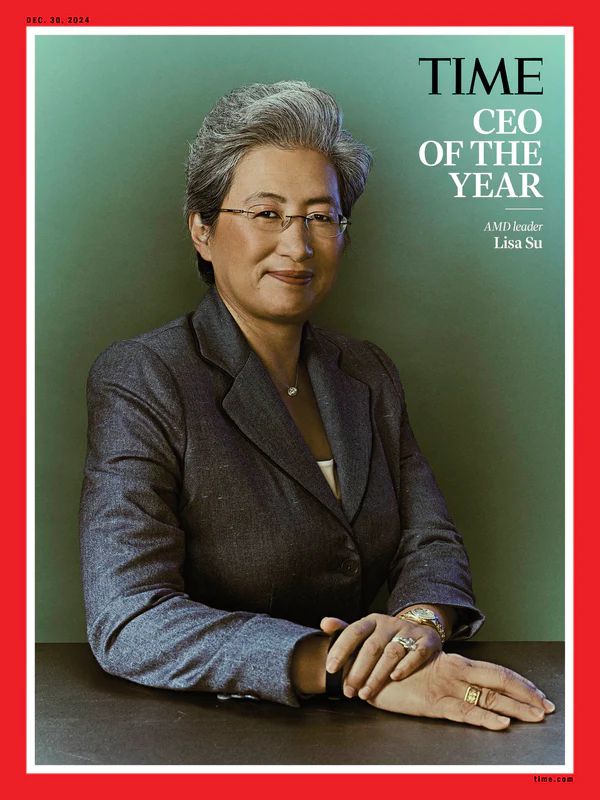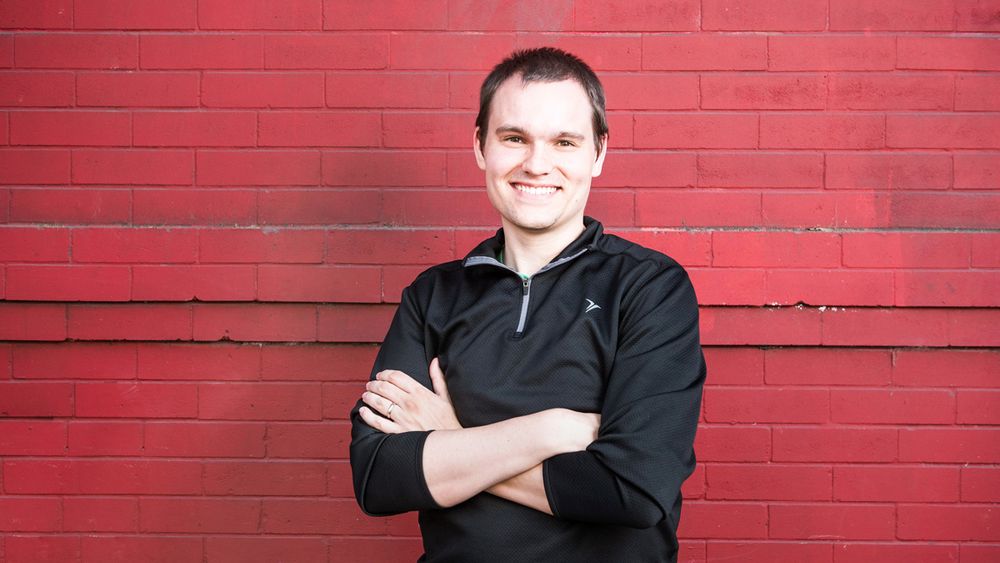Thanks for reading!
Follow me @alexanderkovalov.com for more business and startup content in your feed!
And if you like this, checkout my previous post about Marc Andreessen and the future of AI:
bsky.app/profile/alex...
17.12.2024 19:17 — 👍 2 🔁 0 💬 0 📌 0
7/ "AI’s energy consumption is a challenge, but it’s also a tool for greater efficiency."
Lisa acknowledged that AI systems require massive energy inputs, but she believes their potential to solve problems outweighs this (for example, speed of drug development in medicine).
17.12.2024 19:17 — 👍 0 🔁 0 💬 1 📌 0
6/ "Competition is healthy, but collaboration drives progress."
Lisa stressed that the semiconductor industry is a space where no single company can do everything alone.
AMD collaborates with companies (ex. Intel), on shared challenges while pushing their own boundaries to lead in innovation.
17.12.2024 19:17 — 👍 0 🔁 0 💬 1 📌 0
5/ "Technology evolves in waves; when you reach a plateau, the next big breakthrough follows."
Lisa rejected the idea that AI is "plateauing."
She explained that innovation happens in cycles: new technologies take off, hit limitations, and inspire the next big leap.
17.12.2024 19:17 — 👍 0 🔁 0 💬 1 📌 0
4/ "In the next 3-5 years, we’ll see advanced chips being manufactured in the U.S."
Lisa shared that investments in U.S. chip manufacturing are 📈 , and Arizona has become a hub for some of the most advanced chip manufacturing.
AMD already seeing promising results from local production facilities.
17.12.2024 19:17 — 👍 0 🔁 0 💬 1 📌 0
3/ "Chips are now a matter of national security."
While there are restrictions on exporting advanced chips to China, she emphasized the importance of maintaining balance and dialogue to protect both national security and global trade opportunities.
17.12.2024 19:17 — 👍 0 🔁 0 💬 1 📌 0
2/ "Chips power everything you do, from your car to your smartphone and beyond."
Chips now sit at the backbone of economic systems, powering everything from home electronics to complex infrastructures.
This importance has made semiconductor supply chains a top political priority.
17.12.2024 19:17 — 👍 0 🔁 0 💬 1 📌 0
1/ "AI is the most transformational technology I’ve seen in my career."
Lisa Su emphasized that we’re at the very beginning of AI’s journey, describing it as a 5-10 year cycle.
Current AI systems may not always be perfect, but their ability to revolutionize industries is undeniable.
17.12.2024 19:17 — 👍 0 🔁 0 💬 1 📌 0

Meet Lisa Su - TIME’s CEO of the Year.
She leads AMD, the American chip-making company she brought to a $123 billion valuation.
Here are her 7 thoughts on the future of AI and the semiconductor industry🧵:
17.12.2024 19:17 — 👍 1 🔁 0 💬 1 📌 0
If someone calls us “just a ChatGPT wrapper,” I might smash their face🙂
But honestly, I’m confident we’ll hear that less now. The market has spoken.
16.12.2024 18:27 — 👍 0 🔁 0 💬 0 📌 0
I know because we’ve spent countless hours fine-tuning the model and teaching it the intricacies of marketing metrics and dimensions.
I once told my co-founder:
16.12.2024 18:27 — 👍 0 🔁 0 💬 1 📌 0
which is using multiple foundation models for different tasks to improve input/output, speed, and quality.
This isn’t just about wrapping ChatGPT - it’s about innovation and solving specific problems.
I built Ranalyze AI - the tool that helps to analyze your marketing data.
It’s hard work. Why?
16.12.2024 18:27 — 👍 0 🔁 0 💬 1 📌 0
The ChatGPT store turned out to be a nothingburger.
Meanwhile, AI tools and applications like Glean, CaseText, Harvey, Photoroom, and OpusClip crushed the market, generating tens of millions in revenue.
A trend YC now sees in its latest YC batches is multi-model orchestration, which is...
16.12.2024 18:27 — 👍 0 🔁 0 💬 1 📌 0
In 2024, the ChatGPT wrapper myth was officially debunked.
It’s now validated by Y Combinator.
The conventional wisdom was that anything built on top of ChatGPT was just a "GPT wrapper," and that the ChatGPT app store would obliterate startups creating their own applications.
But guess what?
16.12.2024 18:27 — 👍 0 🔁 0 💬 1 📌 0
That was a Zapier’s playbook for scaling that you can repeat.
Thanks for reading!
Follow me @alexanderkovalov.com for more insights about business, startups and marketing!
11.12.2024 18:37 — 👍 0 🔁 0 💬 0 📌 0
9/ Do Not Afraid To Stand Out
Wade Foster emphasized embracing their quirks and avoiding the temptation to conform.
Using playful plan names like "Amps, Volts, and Ohms" reflected their distinct personality and captured user attention and helped them stand out in a competitive SaaS market.
11.12.2024 18:37 — 👍 0 🔁 0 💬 1 📌 0
8/ Focus on Repeatable Growth
To ensure scalable growth, the team built mechanisms like programmatic SEO and app directories.
Their search-driven approach allowed them to capture customers searching for integrations like "PayPal to Salesforce."
11.12.2024 18:37 — 👍 0 🔁 0 💬 1 📌 0
7/ Experiment with Pricing
They experimented with pricing models to balance affordability and value.
For example, the initial pricing model was based on the Fibonacci sequence ($1, $23, $58), which was unconventional but attention-grabbing.
11.12.2024 18:37 — 👍 0 🔁 0 💬 1 📌 0
6/ Scale Customer Acquisition
Zapier invested in content marketing, creating an app directory and educational resources to improve SEO and attract users searching for integrations.
Partnerships with SaaS vendors also provided exposure and drive traffic to their website.
11.12.2024 18:37 — 👍 1 🔁 0 💬 2 📌 0
5/ Start Lean and Agile
In the early days, the founders managed all aspects of the business, including customer support, marketing, and product development.
Their first hire was a customer support representative to free up time for product improvements.
11.12.2024 18:37 — 👍 0 🔁 0 💬 1 📌 0
4/ Engage with Communities
The team actively participated in online forums where potential users were discussing integration needs.
By engaging with these communities, they found early customers who were eager for solutions.
11.12.2024 18:37 — 👍 0 🔁 0 💬 1 📌 0
3/ Focus on Product-Led Growth (PLG)
Zapier leveraged a self-serve model, allowing users to sign up and use the product without interacting with a salesperson.
This approach resonated with their target audience - users of SaaS tools like MailChimp and Dropbox.
11.12.2024 18:37 — 👍 0 🔁 0 💬 1 📌 0
2/ Launch Early and Iterate
The team embraced a "launch early and often" approach, valuing real-world feedback over perfection.
Early iterations of Zapier were far from polished but functional enough to solve customer problems.
11.12.2024 18:37 — 👍 0 🔁 0 💬 1 📌 0
1/ Obsess Over the Customer Experience
Zapier's success heavily relied on its commitment to improving the user experience for non-technical users.
Wade Foster personally onboarded dozens of customers, noting their struggles and relaying the issues back to the engineering team for improvements.
11.12.2024 18:37 — 👍 0 🔁 0 💬 1 📌 0

Wade Foster scaled Zapier to a $5 billion valuation in just 3 years.
His approach? Obsess over customers, launch early, and keep things weird.
Here are 9 lessons from Zapier’s journey that every startup founder needs to know:🧵👇
11.12.2024 18:37 — 👍 1 🔁 0 💬 1 📌 0
Hi @skpodila.bsky.social
Can you please add me to your list?
go.bsky.app/VrJki2f
09.12.2024 22:24 — 👍 0 🔁 0 💬 0 📌 0
These 5 principles rule my team meetings:
✅ Never Have a Meeting Without an Agenda
✅ Send Me Your Numbers Upfront
✅ Cut the BS - Get Straight to the Issues
✅ Appoint a Meeting Host
✅ Follow Up with a Meeting Summary and To-Do List
Time is money - stop wasting both with unproductive meetings.
09.12.2024 20:10 — 👍 0 🔁 0 💬 0 📌 0
Additionally, the Host can assign tasks in Asana to ensure accountability and follow-through.
This ensures that nothing discussed in the meeting is lost and everyone knows their responsibilities moving forward.
09.12.2024 20:10 — 👍 0 🔁 0 💬 1 📌 0
The Host is responsible for sending all participants a summary of the meeting’s main points and a clear next-steps or to-do list.
This Meeting Memo is documented in Google Docs, saved, and accessible to the entire team.
09.12.2024 20:10 — 👍 0 🔁 0 💬 1 📌 0
5/ Follow Up with a Meeting Summary and To-Do List
The minute a meeting ends, people move on and forget half of what was discussed.
Not on my team.
09.12.2024 20:10 — 👍 0 🔁 0 💬 1 📌 0
Building rough.app
I also unironically blog on linkedin https://www.linkedin.com/build-relation/newsletter-follow?entityUrn=7221287561531392002
Product Marketer
Tech Startups
olenabomko.com
LinkedIn ▶️ https://www.linkedin.com/in/olenabomko/
Growth Playbooks ▶️ https://olenabomko.gumroad.com
I help startup founders double their MRR with outside-the-box marketing cheat sheets 🦄
Work with me: natiakurdadze.com
Tinkering with LLMs and robots
UK based Demand Gen Marketer>CMO of 15 years. Tongue-in-cheeker-er. Magic The Gathering touched me. Dad of legends. On a journey to complete a #Duskmourn Master set (40 more to go).
I have helped 1000s of engineers sharpen their skills and find jobs.
Full-time Engineering VP and part-time computer science instructor. Always mentoring & always learning. Disgruntled but optimistic. I like photography & music & photography & ampersands.
Building AI agent computers @ https://www.agentstation.ai/
Solopreneur and digital nomad, building tech products while exploring the world. Starting a new #buildinpublic journey.
⬆️ liftmycv.com ← Job search AI agent
👨💻 danzaitsev.com ← Follow my journey
Engineer @rollsroyce | Building jet engines ✈️ by day, indie SaaS by night | postopus.app | nextstepjs.com | mindtrajour.com
Follow and join the journey.
💸 Hoping to side-project my way out of my 9 to 5.
👨💻 ItsChrisRay.com - Check out all my projects
🔵 TrendSpotter.blue - Find trending posts on Bsky
💡 EasyStartupIdeas.com - Start a business you love
An indie hacker building the future of SaaS subscription management and billing.
Working on @billabear.com.
Posts about building a SaaS, tv shows, and random stuff.
The solopreneur on the road to freedom.
shipped.club $2k/month
blacktwist.app $600/month
🚀 Founder erfindergeist.io & tradojo.com • MVPs, Tools & Automations
🇭🇷 🇦🇹
• 👨💻 Building awesome products on the internet
• 💻 Bootstrapping, SaaS, Development, AI
Career(s):
Optimization and Innovation Expert
My Personal Interests:
Startups 💸🤑
Business Development 💹💰
Video Games 🕹️🎮
Standup Comedy 🎭🎤
Cannabis 🔥💨
Founder
Custom dashboards and workflow automation for growing brands and agencies
mayinsights.com
Founder of https://aibrandscan.com/ 👉 monitor what AI says about your brand + rank higher in ChatGPT, Claude & Perplexity. AI SEO tips 🤖
Building with purpose, working with balance.
🚀 Founder of
pixelcave.com
🔥 Building
tailkit.com
pinemix.com
taildashboards.com
taildrops.com
bootstrap.design
building...
📸 wunderpics.com
🌊 picklewave.com
📍los angeles / bangkok
Building https://selfmailkit.com (save up to 98% on email costs). Creator of https://scaletozeroaws.com. Two products acquired.
Senior Software Engineer & Solopreneur 🇸🇪. Building quality apps

